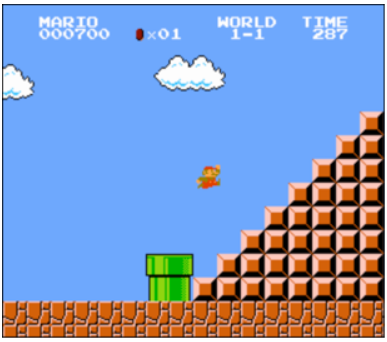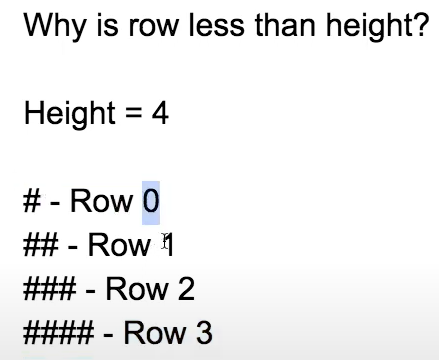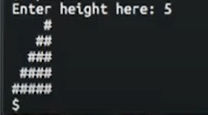Create the Mario pyramid using C
Computer Science 50 — CS50 Harvard University

The main goal here is to create a program that prints out the pyramid on the right side.
On the Youtube channel, CS50 Made easy there is a step-by-step helpful and didactic which I will summarize here in this post.
Understanding the problem
First, enter a number to set how big the pyramid will be.
Height: 1 to 8 — Attention, negative numbers are not possible or bigger than 8. Set a function, do-while loop;
int main(void) //the same idea when clicking in the scratch button
{
int height, row, column, space;
do
{
height = get_int(“HEIGHT: “);
}
// in this line the program will check if it is true
while (height < 1 || height > 8);
Create the pyramid using the for a loop — Set the rows, the columns.
Remember that, the pyramid should be on the right side, therefore, it is necessary to fill up with spaces to take the hashes (#) to the other side of the screen.
for (row = 0; row < height; row++)
{
~~~~for (space = 0; space < height — row — 1;space++)
~~~~{
~~~~~~~~printf(“ “);
~~~~}
~~~~for(column=0; column <= row; column++)
~~~~{
~~~~~~~~printf(“#”);
~~~~}
printf(“\n”);
}
The logic behind the for loop row:
As long as the row is less than height print a new line.
for (row = 0; row < height; row++)
printf(“\n”);

Row 0 is less than 4 so, print one new line.
Row 1 is less than 4 so, print one new line.
Row 2 is less than 4 so, print one new line.
Row 3 is less than 4 so, print one new line.
Row 4 is EQUAL to 4 so, stop here.
Well, in the exercise, it is not required only rows but also hashes. How to do that?
The logic behind the for loop column:
Another loop, nested to the row loop.
~~~~for(column=0; WHAT KIND OF CONDITION SHOULD BE HERE? ; column++)
~~~~{
~~~~~~~~printf(“#”);
~~~~}
Column > Height? — When a column is less than height print #.

Height: 4
Column 0 is less than Height, so print #
Column 1 is less than Height, so print #
Column 2 is less than Height, so print #
Column 3 is less than Height, so print #
Column 4 EQUAL to Height, so stop it.
Seems to work, but it’s not a pyramid so a block.
What about Column ≤ Height?
Column 0 is equal to or less than the height (4) — Less #
Column 1 is equal to or less than the height (4) — Less ##
Column 2 is equal to or less than the height (4) — Less ###
Column 3 is equal to or less than the height (4) — Less ####
Column 4 is equal to or less than the height (4) — Equal, STOP IT!
When for loop is checking the condition Column ≤ Height, the formula will be the number of columns equivalent to the number of # +1.
Accordingly to the CS50 Made easy the logic for this loop is different than mine. Once the column loop is nested in the row loop, every time row increases, the column is initialized to 0. For example:
First loop
Row= 0
Column = 0
Column ≤ Row? Yes, so print #
First loop
Row= 0
Column = 1
Column ≤ Row? No, so stop and go to the next loop which initializes in the next row
Second loop
Row= 1
Column = 0
Column ≤ Row? Yes, so, print #
Second loop
Row= 1
Column = 1
Column ≤ Row? Yes, so, print another # — RESULT: ##
Second loop
Row= 1
Column = 2
Column ≤ Row? No, so stop it.
As it is possible to figure it out, there is a pattern that will repeat until reaching the Height number input into the program.

The logic behind the for loop space:
To convert a pyramid left align to right align is required paces.

The relationship between Height, Spaces, and Rows is:
Height 4, Row 0, 3 Spaces
Height 4, Row 1, 2 Spaces
Height 4, Row 2, 1 Space
Height 4, Row 3, 0 Space.
Height-Row-1 = Number of spaces
Bringing it to the code world, the spaces loop needs come before hashes. As shown in the image, the spaces are before hashes.
for(space = 0; space < height-row-1; space++)
{
prinft(“ ”);
}
There we go!

I hope you understand it!
